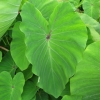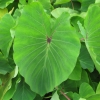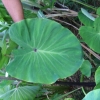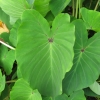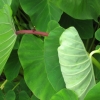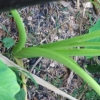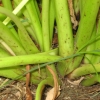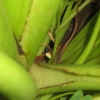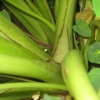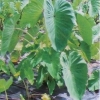Use As Food
Mainly as a table taro.
Distribution
Little known variety of limited distribution.
General Characteristics
Medium in height, moderately spreading, stocky, maturing within 9 to 12 months, producing from 2 to 5 oha; similar to Manapiko, in that on the leaf purple streaks run out from the piko into the ribs and veins, but with a much lighter Hā (Petiole) and Lau or lū ‘au (Leaf blade).
Ha (Petiole)
70 to 85 cm. long, rigid, light yellowish-green, indistinctly pale pinkish to whitish at edge, light reddish-purple at apex, white for 3 to 4 cm. above kōhina (base), abruptly curved at apex. This variety, grown at CTAHR Waimanalo, can have a unique hook that grows off the petiole.
Lau or Lu'au(Leaf Blade)
45 to 55 cm. long, 30 to 35 cm. wide, 35 to 40 cm. from tip to base of sinus (māwae), arrow head shaped, vertical, light green; margins slightly wave-like (undulate); piko conspicuously is blotched with dark purple streaks that run from the piko into the veins; veins reddish on lower surface of round leaf section (lobes); round leaf section (lobes) acute with deep, wide lihi māwae (sinus).
'I'o kalo (Corm)
Flesh white with yellowish fibers; skin cream-colored.
Pua (Flower)
Hā (peduncle) light green; flower cover (spathe) about 30 cm, long, the lower tubular portion about 5 cm. long, light green with purplish area at kōhina (base), the upper portion yellow, rather widely open at kōhina (base) upon maturity.
Remarks
You can read about horticulturist Gerrit Parmile Wilder at this University of Hawai'i botany website. In July 2011, canoes from across the Pacific gathered in Hawai'i. The Tahitians visited Limahuli Gardens on Kauai. They saw this variety, said this was a kalo of their ancestors, and its name is Veo, per KW. Like variety Manapiko, Tahitian lau also have dark purple streaks that run from the piko into the veins.

